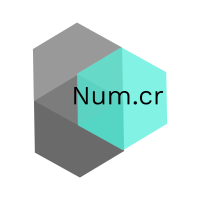bottle

Num.cr is the core shard needed for scientific computing with Crystal
- Website: https://crystal-data.github.io/num.cr
- API Documentation: https://crystal-data.github.io/num.cr/
- Source code: https://github.com/crystal-data/num.cr
- Bug reports: https://github.com/crystal-data/num.cr/issues
It provides:
- An n-dimensional
Tensordata structure - Efficient
map,reduceandaccumulateroutines - GPU accelerated routines backed by
OpenCL - Linear algebra routines backed by
LAPACKandBLAS
Prerequisites
Num.cr aims to be a scientific computing library written in pure Crystal.
All standard operations and data structures are written in Crystal. Certain
routines, primarily linear algebra routines, are instead provided by a
BLAS or LAPACK implementation.
Several implementations can be used, including Cblas, Openblas, and the
Accelerate framework on Darwin systems. For GPU accelerated BLAS routines,
the ClBlast library is required.
Num.cr also supports Tensors stored on a GPU. This is currently limited
to OpenCL, and a valid OpenCL installation and device(s) are required.
Installation
Add this to your applications shard.yml
dependencies:
num:
github: crystal-data/num.cr
Several third-party libraries are required to use certain features of Num.cr.
They are:
- BLAS
- LAPACK
- OpenCL
- ClBlast
While not at all required, they provide additional functionality than is provided by the basic library.
Just show me the code
The core data structure implemented by Num.cr is the Tensor, an N-dimensional
data structure. A Tensor supports slicing, mutation, permutation, reduction,
and accumulation. A Tensor can be a view of another Tensor, and can support
either C-style or Fortran-style storage.
Creation
There are many ways to initialize a Tensor. Most creation methods can
allocate a Tensor backed by either CPU or GPU based storage.
[1, 2, 3].to_tensor
Tensor.from_array [1, 2, 3]
Tensor(UInt8).zeros([3, 3, 2])
Tensor.random(0.0...1.0, [2, 2, 2])
ClTensor(Float32).zeros([3, 2, 2])
ClTensor(Float64).full([3, 4, 5], 3.8)
Operations
A Tensor supports a wide variety of numerical operations. Many of these
operations are provided by Num.cr, but any operation can be mapped across
one or more Tensors using sophisticated broadcasted mapping routines.
a = [1, 2, 3, 4].to_tensor
b = [[3, 4, 5, 6], [5, 6, 7, 8]].to_tensor
# Convert a Tensor to a GPU backed Tensor
acl = a.astype(Float64).gpu
puts Num.add(a, b)
# a is broadcast to b's shape
# [[ 4, 6, 8, 10],
# [ 6, 8, 10, 12]]
When operating on more than two Tensors, it is recommended to use map
rather than builtin functions to avoid the allocation of intermediate
results. All map operations support broadcasting.
a = [1, 2, 3, 4].to_tensor
b = [[3, 4, 5, 6], [5, 6, 7, 8]].to_tensor
c = [3, 5, 7, 9].to_tensor
a.map(b, c) do |i, j, k|
i + 2 / j + k * 3.5
end
# [[12.1667, 20 , 27.9 , 35.8333],
# [11.9 , 19.8333, 27.7857, 35.75 ]]
Mutation
Tensors support flexible slicing and mutation operations. Many of these
operations return views, not copies, so any changes made to the results might
also be reflected in the parent.
a = Tensor.new([3, 2, 2]) { |i| i }
puts a.transpose
# [[[ 0, 4, 8],
# [ 2, 6, 10]],
#
# [[ 1, 5, 9],
# [ 3, 7, 11]]]
puts a.reshape(6, 2)
# [[ 0, 1],
# [ 2, 3],
# [ 4, 5],
# [ 6, 7],
# [ 8, 9],
# [10, 11]]
puts a[..., 1]
# [[ 2, 3],
# [ 6, 7],
# [10, 11]]
puts a[1..., {..., -1}]
# [[[ 6, 7],
# [ 4, 5]],
#
# [[10, 11],
# [ 8, 9]]]
puts a[0, 1, 1].value
# 3
Linear Algebra
Tensors provide easy access to power Linear Algebra routines backed by
LAPACK and BLAS implementations, and ClBlast for GPU backed Tensors.
a = [[1, 2], [3, 4]].to_tensor.map &.to_f32
puts a.inv
# [[-2 , 1 ],
# [1.5 , -0.5]]
puts a.eigvals
# [-0.372281, 5.37228 ]
acl = a.opencl
bcl = a.opencl
puts acl.gemm(bcl).cpu
# [[7 , 10],
# [15, 22]]
puts a.matmul(a)
# [[7 , 10],
# [15, 22]]
DataFrames
For more structured data, consider using a DataFrame
df = DataFrame.from_items(
foo: [1, 2, 3, 4, 5].to_tensor,
bar: [2.73, 3.1, 4.8, 5.1, 3.2],
)
puts df
# foo bar
# 0 1 2.73
# 1 2 3.1
# 2 3 4.8
# 3 4 5.1
# 4 5 3.2
A DataFrame maintains types while still providing convenient
mapping and reduction operations
puts df.c[:foo]
# 0 1
# 1 2
# 2 3
# 3 4
# 4 5
# Name: foo
# dtype: Int32
puts typeof(df.c[:foo])
# Series(Int32, Int32)
puts df.sum
# foo 15
# bar 18.93
With operations that broadcast across the DataFrame
puts df.greater(df.mean)
# foo bar
# 0 false false
# 1 false false
# 2 false true
# 3 true true
# 4 true false
Review the documentation for full implementation details, and if something is missing, open an issue to add it!